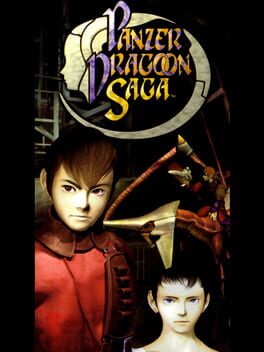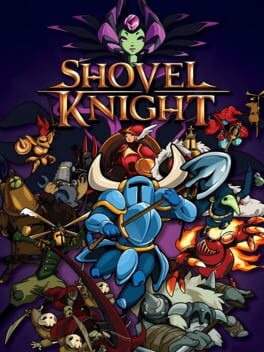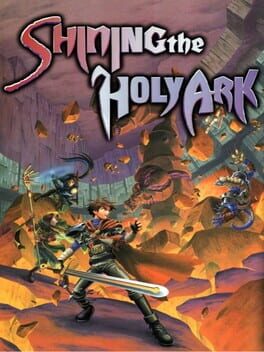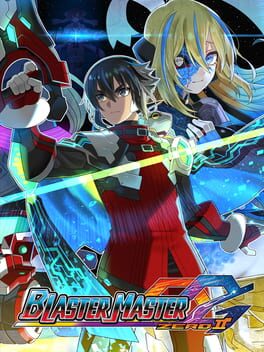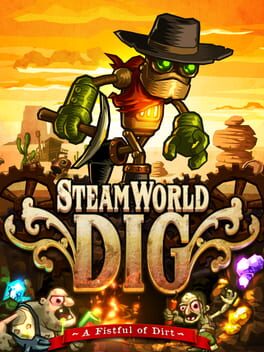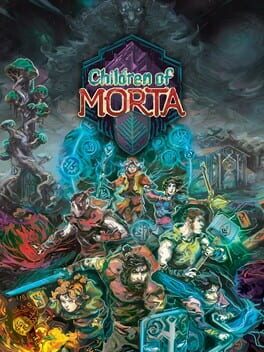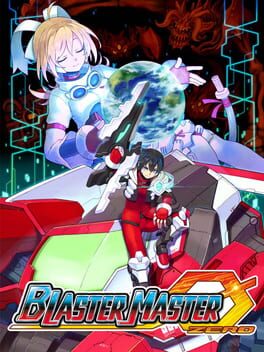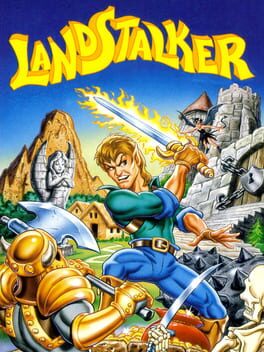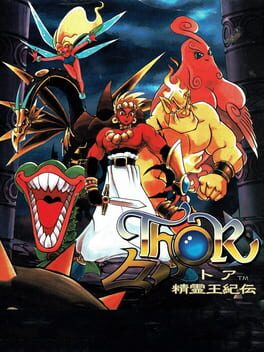GhaleonEB
BACKER
2017
Every now and then a game comes along that announces itself as special from the moment you start up. More rare are games so impactful that the genre can be cleanly divided into before, and after. Such is Hollow Knight: There's metroidvanias before it came out, and after it's earth-shaking impact.
At the surface of Hollow Knight is the sprawling, beautifully constructed and interconnected world design, the evocative and often rousing music, the hand-drawn art and animation, the perfect gameplay. The tremendous freedom with which we can explore the world. There are vividly realized characters, sharply characterized with through art, voice and dialogue that bring them to life. It's truly incredible the way Myla and Hornet - to pick but two examples - become fully-realized characters we care deeply about despite their relatively short screen time.
Another level down, the initially typical story of a fallen kingdom being explored is steeped in an original and compelling story. Through rich worldbuilding we learn of ancient enemies, tragedy, heroism, tribal pacts. We encounter characters simultaneously silly and affecting (somehow), like a dung beetle whose joyful demeaner and optimism mask a tragic past.
Amidst a heavy story Hollow Knight is also utterly hilarious, including the payoff to a joke developed so carefully that the punchline lands as unexpectedly as it is perfect. It's one of the funniest things I've ever seen in a game (let's just say the object of someone's obsession takes on a very odd fantasy). And yet somehow the humor melds with the world rather than clashing with it, a balancing act that is really tough to pull off.
Yet another level down, we find the deeper secrets of the story, the nooks and crannies of the world, the deep lore - and the themes of what it's really about. Hollow Knight has come to mean a great deal to me. It's a special game, yes. It plays beautifully, sure. But it's also a game with an insight into human - and bug - nature. Ultimately, all things must accept an end, whether we want to or not. It's how we respond to that end that defines us.
At the surface of Hollow Knight is the sprawling, beautifully constructed and interconnected world design, the evocative and often rousing music, the hand-drawn art and animation, the perfect gameplay. The tremendous freedom with which we can explore the world. There are vividly realized characters, sharply characterized with through art, voice and dialogue that bring them to life. It's truly incredible the way Myla and Hornet - to pick but two examples - become fully-realized characters we care deeply about despite their relatively short screen time.
Another level down, the initially typical story of a fallen kingdom being explored is steeped in an original and compelling story. Through rich worldbuilding we learn of ancient enemies, tragedy, heroism, tribal pacts. We encounter characters simultaneously silly and affecting (somehow), like a dung beetle whose joyful demeaner and optimism mask a tragic past.
Amidst a heavy story Hollow Knight is also utterly hilarious, including the payoff to a joke developed so carefully that the punchline lands as unexpectedly as it is perfect. It's one of the funniest things I've ever seen in a game (let's just say the object of someone's obsession takes on a very odd fantasy). And yet somehow the humor melds with the world rather than clashing with it, a balancing act that is really tough to pull off.
Yet another level down, we find the deeper secrets of the story, the nooks and crannies of the world, the deep lore - and the themes of what it's really about. Hollow Knight has come to mean a great deal to me. It's a special game, yes. It plays beautifully, sure. But it's also a game with an insight into human - and bug - nature. Ultimately, all things must accept an end, whether we want to or not. It's how we respond to that end that defines us.
1998
Turning a 3D shooter series into an RPG may seem odd if you are unfamiliar with the prior two Panzer Dragoon games. On paper, they are relatively brief rail shooters. Which is true, but for the breathtaking imagination on display, and the richness of the world building each game packs from end to end. In each game we glimpse a small part of a larger world, filled with history, mysteries, political factions, struggle, danger and wonder.
Turning to an RPG to explore some of that world makes perfect sense - Team Andromeda had build too large of a world to be contained in shooters alone. Revisiting Panzer Dragoon Saga for the first time in 15+ years, I'm struck once again by how audacious it is on all fronts. At every turn, this game defies convention and goes its own way, and all if it works. The world is almost relentlessly bleak, with humanity scraping for survival on the ground and fighting over access to ancient secrets in the sky. The art and music combine to create a mood and set a tone that his wholly unique, making the world where humanity is knocked so far down the food chain that hunters are constantly in fear of being hunted themselves feel vividly real.
The combat system has - somehow - never been imitated, despite it's brilliant adaptation of Panzer Dragoon's core gameplay, a system that looks and feels like a shooter but has the bones of turn-based positional battle.
The story seldom takes a predictable turn, yet there's never a twist for the sake of it; this is a character-driven story through and through. The events in and around the gorgeous, ethereal water ruins of Uru form a key sequence where enemies become tense allies, motivations clarify and alliances blur - and the story flows entirely from the clash of personalities and ideas, not contrivances.
I love the world this series, and this game, create. I love the feeling of flying our dragon through valleys, fields, tunnels and the epic Tower. I love the aching, mournful tone that feels rooted in real struggle. The undulating, cohesive soundtrack where every track is perfectly evocative of it setting. And how in an era when developers were discovering boob physics, Team Andromeda had an absolute refusal to sexualize Azel or deploy a male gaze upon her, creating one of gaming's most compelling characters along the way.
The one knock on Saga is the difficulty - simply put, the game is easy. But it's also relentlessly compelling and engaging. Being hard was never the goal: Panzer Dragoon is all about immersing us in a unique, beautiful, evocative and strange world, and it succeeds on every level. A timeless masterpiece.
Turning to an RPG to explore some of that world makes perfect sense - Team Andromeda had build too large of a world to be contained in shooters alone. Revisiting Panzer Dragoon Saga for the first time in 15+ years, I'm struck once again by how audacious it is on all fronts. At every turn, this game defies convention and goes its own way, and all if it works. The world is almost relentlessly bleak, with humanity scraping for survival on the ground and fighting over access to ancient secrets in the sky. The art and music combine to create a mood and set a tone that his wholly unique, making the world where humanity is knocked so far down the food chain that hunters are constantly in fear of being hunted themselves feel vividly real.
The combat system has - somehow - never been imitated, despite it's brilliant adaptation of Panzer Dragoon's core gameplay, a system that looks and feels like a shooter but has the bones of turn-based positional battle.
The story seldom takes a predictable turn, yet there's never a twist for the sake of it; this is a character-driven story through and through. The events in and around the gorgeous, ethereal water ruins of Uru form a key sequence where enemies become tense allies, motivations clarify and alliances blur - and the story flows entirely from the clash of personalities and ideas, not contrivances.
I love the world this series, and this game, create. I love the feeling of flying our dragon through valleys, fields, tunnels and the epic Tower. I love the aching, mournful tone that feels rooted in real struggle. The undulating, cohesive soundtrack where every track is perfectly evocative of it setting. And how in an era when developers were discovering boob physics, Team Andromeda had an absolute refusal to sexualize Azel or deploy a male gaze upon her, creating one of gaming's most compelling characters along the way.
The one knock on Saga is the difficulty - simply put, the game is easy. But it's also relentlessly compelling and engaging. Being hard was never the goal: Panzer Dragoon is all about immersing us in a unique, beautiful, evocative and strange world, and it succeeds on every level. A timeless masterpiece.
2014
I wanted to like this more than I did, having heard about it for so long. I think in the end it's a case of the game being well made, but it just wasn't really for me. I enjoyed the sprite work and world design, how the game flows and progresses, the abundance of secrets. The character designs are all great and memorable. But I didn't enjoy the gameplay as much as I hoped, and I found the old-school approach to difficultly - which can often veer into feeling quite cheap - was off-putting. Still, I'm glad I played it, as this was a fun romp overall. And I get so many references now!
I played this as part of the Treasure Trove collection, though it's the only part of that collection I finished.
I played this as part of the Treasure Trove collection, though it's the only part of that collection I finished.
1996
Shining in the Darkness is one of my favorite RPGs - love me a good dungeon crawl - and this is a remarkable direct sequel. It provides enough context to be a stand-alone game, while both serving as a direct sequel to Shining in the Darkness, and as a prequel to Shining Force III. It's an remarkable balancing act but they pull it off.
Entirely first person, we can now explore towns, castles and other interiors in addition to the dungeons and caves. Greatly expanded in scope, there are now numerous caves, shrines and other dungeons to explore, a contrast from the monolithic labyrinth of Darkness. Similar to the Shining Force games, the environments are packed with secrets that encourage and reward exploration, and with so much more area to explore, there's a lot more to find. Notable is the unusual but brilliant fairy system that serves as our preemptive combat strike, rewarding bonus XP and gold.
The dungeons are all very unique and superbly designed. Every one has new ideas packed into them, from finding new passageways and boats in the waterways, to having to weave navigating on the ceiling and floor in another. And the music is simply incredible throughout. A couple of personal favorites:
https://www.youtube.com/watch?v=bEfows0mD6A
https://www.youtube.com/watch?v=uwY1csmv4gs
The quest is long, tough, varied and packed with great characters and ideas. I love that while there are more party members than you can have active at once, even those that did not participate in battle will level up with you, so no one falls behind. You never get locked into a core set and can adjust the party on the fly as needed - which is frequently needed due to the very challenging boss fights.
I love everything about this game. The lone major flaw in the performance: combat in particular suffers from frequent slow down. With some additional optimization, the game would run so much better. Still, this is one heck of a great dungeon crawl and worth playing any way you can if that's your jam.
Entirely first person, we can now explore towns, castles and other interiors in addition to the dungeons and caves. Greatly expanded in scope, there are now numerous caves, shrines and other dungeons to explore, a contrast from the monolithic labyrinth of Darkness. Similar to the Shining Force games, the environments are packed with secrets that encourage and reward exploration, and with so much more area to explore, there's a lot more to find. Notable is the unusual but brilliant fairy system that serves as our preemptive combat strike, rewarding bonus XP and gold.
The dungeons are all very unique and superbly designed. Every one has new ideas packed into them, from finding new passageways and boats in the waterways, to having to weave navigating on the ceiling and floor in another. And the music is simply incredible throughout. A couple of personal favorites:
https://www.youtube.com/watch?v=bEfows0mD6A
https://www.youtube.com/watch?v=uwY1csmv4gs
The quest is long, tough, varied and packed with great characters and ideas. I love that while there are more party members than you can have active at once, even those that did not participate in battle will level up with you, so no one falls behind. You never get locked into a core set and can adjust the party on the fly as needed - which is frequently needed due to the very challenging boss fights.
I love everything about this game. The lone major flaw in the performance: combat in particular suffers from frequent slow down. With some additional optimization, the game would run so much better. Still, this is one heck of a great dungeon crawl and worth playing any way you can if that's your jam.
1986
This was my second Zelda game, after the Link's Awakening remake on Switch, but in a way I've been playing it for years, so massive it this game's influence. The bow, the bombs, the pieces of heart, the dungeons - I've played countless games massively influenced or straight up playing homage to OG Zelda. It was nice to finally play the one that started it all.
It's clear to see what massive leap for adventure / action-RPGs this was. At the time, it was packed with new ideas and a huge scale, and retains the intuitive gameplay, steep challenge, ludicrous numbers of secrets and supremely well designed overworld and dungeons. OG Zelda is STILL better designed than many of the knock-offs I've played.
Still, frustrations abound in some cheap enemies, opaque puzzles, respawning enemies and controls that are never quire as quick as i'd like them to be. Mostly things I suspect are greatly refined in later entries, going by my experience with Link's Awakening. I had a lot of fun learning the references and roots of this genre I've loved for so long.
Played the first quest to completion on NES Classic.
It's clear to see what massive leap for adventure / action-RPGs this was. At the time, it was packed with new ideas and a huge scale, and retains the intuitive gameplay, steep challenge, ludicrous numbers of secrets and supremely well designed overworld and dungeons. OG Zelda is STILL better designed than many of the knock-offs I've played.
Still, frustrations abound in some cheap enemies, opaque puzzles, respawning enemies and controls that are never quire as quick as i'd like them to be. Mostly things I suspect are greatly refined in later entries, going by my experience with Link's Awakening. I had a lot of fun learning the references and roots of this genre I've loved for so long.
Played the first quest to completion on NES Classic.
I was aware of Zelda II's reputation for being an odd duck going into this, but even that did not prepare me. This is a weird game. The leveling system is really strange. How combat is initiated in the overworld is kinda goofy. There's nothing really wrong with the side scrolling action, other than it being punishingly difficult. So it's really different from the first game, which is admirable since the spirit of the first one is still kinda in there.
What really knocks this down is how punishing it all is. Dying brings you back to the shrine at the start of the game, initiating a trek through the ENTIRE overworld to get back. And boy did I die a lot. It's brutal and got so tiring. Mele combat is clunky. Come to mention it, all the actions are rather clunky. It's just not all that fun to actually play.
I commend the game for trying many new things, and I'm aware aspects of it were kind of groundbreaking at the time. But the parts here do not gel into a whole, and there are some just plain bad ideas in the mix (the aforementioned leveling and backtracking, chief among them). This is one of those, glad I experienced it, but will never revisit kind of games. Going by how Nintendo pivoted the series from here, they seemed to feel the same.
Played on NES Classic.
What really knocks this down is how punishing it all is. Dying brings you back to the shrine at the start of the game, initiating a trek through the ENTIRE overworld to get back. And boy did I die a lot. It's brutal and got so tiring. Mele combat is clunky. Come to mention it, all the actions are rather clunky. It's just not all that fun to actually play.
I commend the game for trying many new things, and I'm aware aspects of it were kind of groundbreaking at the time. But the parts here do not gel into a whole, and there are some just plain bad ideas in the mix (the aforementioned leveling and backtracking, chief among them). This is one of those, glad I experienced it, but will never revisit kind of games. Going by how Nintendo pivoted the series from here, they seemed to feel the same.
Played on NES Classic.
Blossom Tales is a charming Zelda-like with a lot of personality. The framing device is a grandpa telling his kids a bedtime story, and his narrative pops in and out of the story throughout. Even better, the kids will argue about what happens in the story - what kind of boss are you about to run into? What kind of puzzle is up next? And rather than be cosmetic, we get to choose which kids' idea grandpa goes with in the story - which shapes what we do next. It's not transformational, but it's a really neat way to integrate the story into the gameplay.
This is, unfortunately, one of the only really original ideas in the game. If you've played a 2D Zelda (or even another Zelda-like), then all of this will be familiar. Get four heart pieces to add a heart to the health meter; park bombs on cracked walls to break them open; get the bow and arrow for range combat and dungeon puzzle solving. It's all very familiar, but done well and with a lovely art style.
Wanted to mention the music in particular as a standout - Josie Brechner's score is a superb chiptune accompaniment to the game, often richly atmospheric (the frost zone them is incredible) and always setting a great mood for the dungeons and areas.
With some more original ideas I think this would have been more interesting, but it's a solid little game regardless.
This is, unfortunately, one of the only really original ideas in the game. If you've played a 2D Zelda (or even another Zelda-like), then all of this will be familiar. Get four heart pieces to add a heart to the health meter; park bombs on cracked walls to break them open; get the bow and arrow for range combat and dungeon puzzle solving. It's all very familiar, but done well and with a lovely art style.
Wanted to mention the music in particular as a standout - Josie Brechner's score is a superb chiptune accompaniment to the game, often richly atmospheric (the frost zone them is incredible) and always setting a great mood for the dungeons and areas.
With some more original ideas I think this would have been more interesting, but it's a solid little game regardless.
What you'd expect from a sequel: more of what made the first good, with refined systems, more expansive levels, a wider variety of stages, and greater use of the overworld map and the way the various pieces fit together.
They basically tried to do more with every part of the game: the action in the vehicle is more dynamic and varied, the top down sections have way more challenge and variety, and the on foot sections are more elaborate. I think they were all successful, though the on foot sections got rather frustrating. I also ran into a soft lock by saving while on foot in a place it turns out you can't get out of, so watch out.
Sill need to play #3, but if it's as good as this one, it should be a lot of fun.
They basically tried to do more with every part of the game: the action in the vehicle is more dynamic and varied, the top down sections have way more challenge and variety, and the on foot sections are more elaborate. I think they were all successful, though the on foot sections got rather frustrating. I also ran into a soft lock by saving while on foot in a place it turns out you can't get out of, so watch out.
Sill need to play #3, but if it's as good as this one, it should be a lot of fun.
2013
Steamworld Dig is a hybrid game in a few ways. Steamworld itself is a steampunk western, but everyone is robots. The digging meanwhile is the classic dig for gems, head up to the surface to upgrade your gear, and then return to mine deeper loop. Only, there's also a fair bit of combat. And platforming. Oh, and it's kind of a metroidvania.
I don't think it all gels, but there's no denying how compelling this world and these characters are, nor how satisfying and tactile the mining is. And that core loop of mine - > upgrade -> explore and then mine some more is very compelling.
I find controls a bit too clunky for either the platforming or action, which frustrates from time to time and takes this down a few notches. But all of the ideas thrown in here are good, just not integrated in a way that always works. Thankfully, the sequel addressed all these issues and then some. Still, this is a fun one and it's neat to see how the sequel carries on the story started here.
I don't think it all gels, but there's no denying how compelling this world and these characters are, nor how satisfying and tactile the mining is. And that core loop of mine - > upgrade -> explore and then mine some more is very compelling.
I find controls a bit too clunky for either the platforming or action, which frustrates from time to time and takes this down a few notches. But all of the ideas thrown in here are good, just not integrated in a way that always works. Thankfully, the sequel addressed all these issues and then some. Still, this is a fun one and it's neat to see how the sequel carries on the story started here.
2019
Children of Morta beautifully intertwines the play, die, upgrade, play loop of a rougue-lite with some terrific storytelling in between. I found all the characters in the family and their dynamic compelling and I was as eager to have another run at a location as I was to see how the story progressed.
I prefer ranged characters - given the choice, I'm always the archer - so I was glad to see some ranged options with the family. But I really disliked the system that forced you to pivot away from your chosen character due to the infection system. Forcing me to play another character I did not enjoy as much got very frustrating. Eventually I would just start a few runs and quit them to get back to my main. Not a good system.
Otherwise, the game could have used some better bosses - the final one in particular - as well as some more variety. But otherwise, I found this game compelling and addictive and enjoyed my time with it.
I prefer ranged characters - given the choice, I'm always the archer - so I was glad to see some ranged options with the family. But I really disliked the system that forced you to pivot away from your chosen character due to the infection system. Forcing me to play another character I did not enjoy as much got very frustrating. Eventually I would just start a few runs and quit them to get back to my main. Not a good system.
Otherwise, the game could have used some better bosses - the final one in particular - as well as some more variety. But otherwise, I found this game compelling and addictive and enjoyed my time with it.
2017
I'd never played any of the original Blaster Master games, but I had friends who had them and so was familiar from seeing them as a kid. I enjoyed this a lot - a fairly straight forward side scrolling action game mixed with top down action scenes with light exploration. On balance the side scrolling action is stronger, but the top-down scenes provide variety and are fun in their own right.
The story is passable, the pixel art strong and the music enjoyable. Feels like there is a lot of room to develop these ideas further, which the sequel confirms.
The story is passable, the pixel art strong and the music enjoyable. Feels like there is a lot of room to develop these ideas further, which the sequel confirms.
This was the first isometric action game I'd played back when it came out. It was a brilliantly designed game then, and revisiting it with a new perspective only made it shine brighter.
Landstalker is an isometric action-RPG that strikes a perfect balance of exploration, action, platforming and puzzle solving, with a great story and set of characters. It's not afraid to be quite difficult at times, and to use its isometric viewpoint to up the challenge: hidden paths, difficulty aligning platforms, many a secret right at your feet if only you could see them. It's also unafraid to punish missteps with backtracking, sending you past a missed platform an onto the level below for the hajillionth time. But a zippy pace mean another shot at that jump is just a few moments away, and the tight controls with full air control are never at fault. Patience and perseverance are required, and this type of challenge may frustrate some.
The only notable flaw is in the sound: I do wish the enemies had at least a few more sound effects for getting hurt and defeated; the same few over and over is unfortunate. But repetitive yelps aside, the other effects are solid and the OST is very strong and catchy.
Landstalker's dungeons are a good illustration of how to leverage a handful of tools in an array of creative ways. Nigel can jump, swing his sword, carry objects and chuck them across a room. The steadily increasing complexity and creativity in how you have to deploy these abilities ramps up throughout the game in ways that constantly surprise and challenge, in dungeons that are sprawling and varied.
This is a masterclass of an isometric action-RPG.
Played on Genesis Mini.
Landstalker is an isometric action-RPG that strikes a perfect balance of exploration, action, platforming and puzzle solving, with a great story and set of characters. It's not afraid to be quite difficult at times, and to use its isometric viewpoint to up the challenge: hidden paths, difficulty aligning platforms, many a secret right at your feet if only you could see them. It's also unafraid to punish missteps with backtracking, sending you past a missed platform an onto the level below for the hajillionth time. But a zippy pace mean another shot at that jump is just a few moments away, and the tight controls with full air control are never at fault. Patience and perseverance are required, and this type of challenge may frustrate some.
The only notable flaw is in the sound: I do wish the enemies had at least a few more sound effects for getting hurt and defeated; the same few over and over is unfortunate. But repetitive yelps aside, the other effects are solid and the OST is very strong and catchy.
Landstalker's dungeons are a good illustration of how to leverage a handful of tools in an array of creative ways. Nigel can jump, swing his sword, carry objects and chuck them across a room. The steadily increasing complexity and creativity in how you have to deploy these abilities ramps up throughout the game in ways that constantly surprise and challenge, in dungeons that are sprawling and varied.
This is a masterclass of an isometric action-RPG.
Played on Genesis Mini.
2018
I didn't think I could beat Celeste. I'm not that great with tough platformers, and Celeste is a tough platformer. But here's the thing: Celeste wanted me to beat it. It told me I was good enough, encouraged me to learn from every one of my (thousands of) deaths, and to keep trying. In the end, the game was right. I could do it, and reaching the apex of the mountain made me so happy.
I love these characters. I love the soundtrack. I love that the game lifted me up every time I fell down. In a very meta-way, Celeste the game became my own Celeste mountain to clear, something I did because it was there and I NEEDED to do it. Celeste is one of the best fusions of theme, story, character and game design ever made.
I love these characters. I love the soundtrack. I love that the game lifted me up every time I fell down. In a very meta-way, Celeste the game became my own Celeste mountain to clear, something I did because it was there and I NEEDED to do it. Celeste is one of the best fusions of theme, story, character and game design ever made.
1996
Legend of Oasis is an interesting sequel. It was apparently turned around very quickly after Beyond Oasis on the Genesis, which explains the game's major shortcoming: the overworld is very, very small. It's essentially just a hub to branch off to the various shrines, which are the main areas of play.
Tiny overworld aside, I love this game. It takes all the ideas that worked so well in Beyond Oasis and expands on them. The combat and weapon systems are refined and improved, with a better and deeper combo system (and permanent weapons, thank goodness). The spirits have even more uses, and with six of them the way we use them to progress in the shrines is even more complex. The hand drawn art is gorgeous, with fluid animation and vivid use of colors. Boss battles are highlights. There's a TON of secrets and large secret areas to find. And there's a lot of off-kilter humor throughout, such as the pitifully moaning zombies.
If the overworld had been fully developed and the controls refined just a touch more - less clunky than Beyond Oasis, but still not perfect - this would be a masterpiece. Still, it's one of my favorite Saturn games, and a really unique take on the top-down action--RPG. There's nothing else that's quite like this unfortunately truncated series.
Tiny overworld aside, I love this game. It takes all the ideas that worked so well in Beyond Oasis and expands on them. The combat and weapon systems are refined and improved, with a better and deeper combo system (and permanent weapons, thank goodness). The spirits have even more uses, and with six of them the way we use them to progress in the shrines is even more complex. The hand drawn art is gorgeous, with fluid animation and vivid use of colors. Boss battles are highlights. There's a TON of secrets and large secret areas to find. And there's a lot of off-kilter humor throughout, such as the pitifully moaning zombies.
If the overworld had been fully developed and the controls refined just a touch more - less clunky than Beyond Oasis, but still not perfect - this would be a masterpiece. Still, it's one of my favorite Saturn games, and a really unique take on the top-down action--RPG. There's nothing else that's quite like this unfortunately truncated series.
2018
I was quite moved by this game, even though I probably did not fully understand it. There's an emotional resonance in the stunning art design that meshed well with the themes on meditations on grief and regret.
I thought GRIS took a little too long to get interesting - bit too much walking straight - and was occasionally frustrated by pushing forward before I intended, leaving optional objectives behind with no way to return. But other than those issues, this was a beautiful and emotional puzzle game.
I thought GRIS took a little too long to get interesting - bit too much walking straight - and was occasionally frustrated by pushing forward before I intended, leaving optional objectives behind with no way to return. But other than those issues, this was a beautiful and emotional puzzle game.

